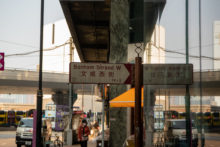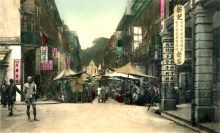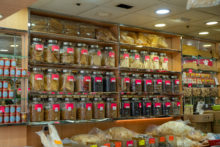Name (English): Bonham Street West
Name (Chinese): 文咸西街
Category: Markets & Malls
Address (English): Bonham Street West Sheung Wan
Address (Chinese):上環文咸西街
Address Google Map Link: https://goo.gl/maps/QLRjv8xQD99Xyrno9
Address longitude and latitude: 22.28715338607424, 114.14850092544923
Nearest MTR Station: Sheung Wan MTR Station Exit A2
Nearest MTR Station Google Map Link: https://goo.gl/maps/K8iVHhij6DzAX8oK6
Nearest MTR Station longitude and latitude: 22.286768560118826, 114.15187139661279
How far from the nearest MTR Station: 2-minute walk from Sheung Wan MTR Station Exit A2
Opening Hours:
MON 00:00 – 23:59
TUE 00:00 – 23:59
WED 00:00 – 23:59
THU 00:00 – 23:59
FRI 00:00 – 23:59
SAT 00:00 – 23:59
SUN 00:00 – 23:59
Recommended Time to Visit: anytime during opening hours
Accessibility Note: easy access

The streets in Hong Kong are rarely left idle. Hong Kong would still try hard to repurpose the destructed areas amid frustration and despair after any disasters–the Bonham Strand West, aka Nam Pak Hong (南北行), is an successful transition from a burned slum to the current 180-year-old cluster of stores selling dried seafood, Chinese medicine and groceries. Take a slow stroll along the street might help you picture the bustling trade center over a century ago that had set a strong basis for the city’s economic development.

Named after George Bonham – the 4th Governor of Hong Kong who led the reconstruction of the strand after the big fire, the Bonham Strand West indeed stretches out further to the east till Queen’s Road Central. As its alternative name suggests, the wide array of stores along the street has been selling goods from the South or “Nam” (南) – South East Asian countries and the North or “Pak” (北) – China.

It attracted lots of businessmen from overseas to visit, especially the Chinese. The growth was at its peak from the late 19th century to the early 20th century, and the colonial government gained huge economic benefits as 90% of its tax revenue came from the trades with Chinese. The locals were also smart enough to set up banks providing financial services like currency exchange and loans for the international businessmen. Little do you know the land price of Nam Pak Hong was even more expensive than that of Central at present!
The situation, however, turned upside down after the UN embargo on trade with China was enacted in the 1950s, where the Nam Pak Hong businesses hit rock bottom. Many small banks were also gradually taken over by global banking, amidst the city’s transition to an international finance center. There was no way out to recover other than a shift in their business models, from initially selling only dried food, spices and daily necessities, to now selling fancy dried seafood, shark fins (!), and rare chinese medicine herbs.
The expensive deer antler and cordyceps might look bizarre, and the shark fins are surly inhumane – but it is hard to deny the fact that these goods have saved Nam Pak Hong from the unknowns.
Try not to miss out the century-old brand Pak Cheong Hong (百昌行) on Bonham Strand West – a three-storey building with distinctively ornate signboards and couplets inscribed with golden Chinese characters at the entrance, which is living witness of the Nam Pak Hong’s changes. You can tell what the business mainly sells from the couplets already: pearl powder, camphor, ginseng, deer antler and cinnamon. If you look for souvenirs to bring home, their Macaque Calculus Powder with a beautiful vintage packaging is a great one to please your friends, which is meant for soothing people from nightmares.

#discoverhongkong #explorehongkong #visithongkong #hongkongtravel #ilovehongkong #heritage #hongkongheritage #culturetrip #hongkongculture #hkhistory #hongkonghistory #hongkongstory #hongkonginsta #instahk #visualhongkong #hkphotography #awesomehongkong #hkinstagram


